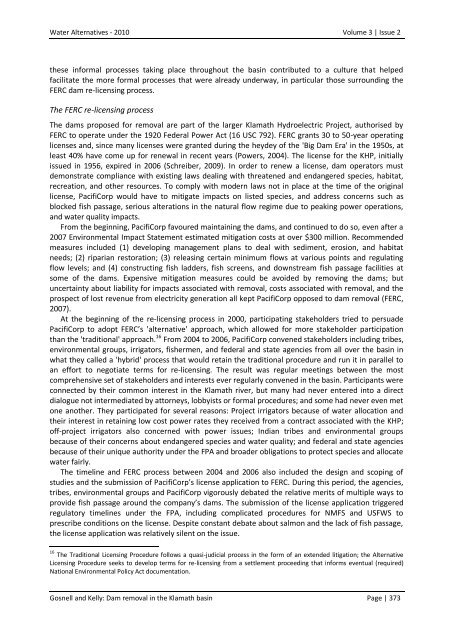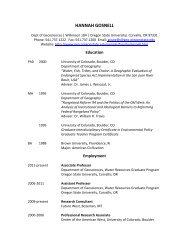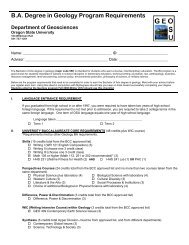Peace on the River? Social-Ecological ... - Water Alternatives
Peace on the River? Social-Ecological ... - Water Alternatives
Peace on the River? Social-Ecological ... - Water Alternatives
You also want an ePaper? Increase the reach of your titles
YUMPU automatically turns print PDFs into web optimized ePapers that Google loves.
<strong>Water</strong> <strong>Alternatives</strong> - 2010 Volume 3 | Issue 2<br />
<strong>the</strong>se informal processes taking place throughout <strong>the</strong> basin c<strong>on</strong>tributed to a culture that helped<br />
facilitate <strong>the</strong> more formal processes that were already underway, in particular those surrounding <strong>the</strong><br />
FERC dam re-licensing process.<br />
The FERC re-licensing process<br />
The dams proposed for removal are part of <strong>the</strong> larger Klamath Hydroelectric Project, authorised by<br />
FERC to operate under <strong>the</strong> 1920 Federal Power Act (16 USC 792). FERC grants 30 to 50-year operating<br />
licenses and, since many licenses were granted during <strong>the</strong> heydey of <strong>the</strong> 'Big Dam Era' in <strong>the</strong> 1950s, at<br />
least 40% have come up for renewal in recent years (Powers, 2004). The license for <strong>the</strong> KHP, initially<br />
issued in 1956, expired in 2006 (Schreiber, 2009). In order to renew a license, dam operators must<br />
dem<strong>on</strong>strate compliance with existing laws dealing with threatened and endangered species, habitat,<br />
recreati<strong>on</strong>, and o<strong>the</strong>r resources. To comply with modern laws not in place at <strong>the</strong> time of <strong>the</strong> original<br />
license, PacifiCorp would have to mitigate impacts <strong>on</strong> listed species, and address c<strong>on</strong>cerns such as<br />
blocked fish passage, serious alterati<strong>on</strong>s in <strong>the</strong> natural flow regime due to peaking power operati<strong>on</strong>s,<br />
and water quality impacts.<br />
From <strong>the</strong> beginning, PacifiCorp favoured maintaining <strong>the</strong> dams, and c<strong>on</strong>tinued to do so, even after a<br />
2007 Envir<strong>on</strong>mental Impact Statement estimated mitigati<strong>on</strong> costs at over $300 milli<strong>on</strong>. Recommended<br />
measures included (1) developing management plans to deal with sediment, erosi<strong>on</strong>, and habitat<br />
needs; (2) riparian restorati<strong>on</strong>; (3) releasing certain minimum flows at various points and regulating<br />
flow levels; and (4) c<strong>on</strong>structing fish ladders, fish screens, and downstream fish passage facilities at<br />
some of <strong>the</strong> dams. Expensive mitigati<strong>on</strong> measures could be avoided by removing <strong>the</strong> dams; but<br />
uncertainty about liability for impacts associated with removal, costs associated with removal, and <strong>the</strong><br />
prospect of lost revenue from electricity generati<strong>on</strong> all kept PacifiCorp opposed to dam removal (FERC,<br />
2007).<br />
At <strong>the</strong> beginning of <strong>the</strong> re-licensing process in 2000, participating stakeholders tried to persuade<br />
PacifiCorp to adopt FERC’s 'alternative' approach, which allowed for more stakeholder participati<strong>on</strong><br />
than <strong>the</strong> 'traditi<strong>on</strong>al' approach. 16 From 2004 to 2006, PacifiCorp c<strong>on</strong>vened stakeholders including tribes,<br />
envir<strong>on</strong>mental groups, irrigators, fishermen, and federal and state agencies from all over <strong>the</strong> basin in<br />
what <strong>the</strong>y called a 'hybrid' process that would retain <strong>the</strong> traditi<strong>on</strong>al procedure and run it in parallel to<br />
an effort to negotiate terms for re-licensing. The result was regular meetings between <strong>the</strong> most<br />
comprehensive set of stakeholders and interests ever regularly c<strong>on</strong>vened in <strong>the</strong> basin. Participants were<br />
c<strong>on</strong>nected by <strong>the</strong>ir comm<strong>on</strong> interest in <strong>the</strong> Klamath river, but many had never entered into a direct<br />
dialogue not intermediated by attorneys, lobbyists or formal procedures; and some had never even met<br />
<strong>on</strong>e ano<strong>the</strong>r. They participated for several reas<strong>on</strong>s: Project irrigators because of water allocati<strong>on</strong> and<br />
<strong>the</strong>ir interest in retaining low cost power rates <strong>the</strong>y received from a c<strong>on</strong>tract associated with <strong>the</strong> KHP;<br />
off-project irrigators also c<strong>on</strong>cerned with power issues; Indian tribes and envir<strong>on</strong>mental groups<br />
because of <strong>the</strong>ir c<strong>on</strong>cerns about endangered species and water quality; and federal and state agencies<br />
because of <strong>the</strong>ir unique authority under <strong>the</strong> FPA and broader obligati<strong>on</strong>s to protect species and allocate<br />
water fairly.<br />
The timeline and FERC process between 2004 and 2006 also included <strong>the</strong> design and scoping of<br />
studies and <strong>the</strong> submissi<strong>on</strong> of PacifiCorp’s license applicati<strong>on</strong> to FERC. During this period, <strong>the</strong> agencies,<br />
tribes, envir<strong>on</strong>mental groups and PacifiCorp vigorously debated <strong>the</strong> relative merits of multiple ways to<br />
provide fish passage around <strong>the</strong> company’s dams. The submissi<strong>on</strong> of <strong>the</strong> license applicati<strong>on</strong> triggered<br />
regulatory timelines under <strong>the</strong> FPA, including complicated procedures for NMFS and USFWS to<br />
prescribe c<strong>on</strong>diti<strong>on</strong>s <strong>on</strong> <strong>the</strong> license. Despite c<strong>on</strong>stant debate about salm<strong>on</strong> and <strong>the</strong> lack of fish passage,<br />
<strong>the</strong> license applicati<strong>on</strong> was relatively silent <strong>on</strong> <strong>the</strong> issue.<br />
16 The Traditi<strong>on</strong>al Licensing Procedure follows a quasi-judicial process in <strong>the</strong> form of an extended litigati<strong>on</strong>; <strong>the</strong> Alternative<br />
Licensing Procedure seeks to develop terms for re-licensing from a settlement proceeding that informs eventual (required)<br />
Nati<strong>on</strong>al Envir<strong>on</strong>mental Policy Act documentati<strong>on</strong>.<br />
Gosnell and Kelly: Dam removal in <strong>the</strong> Klamath basin Page | 373






